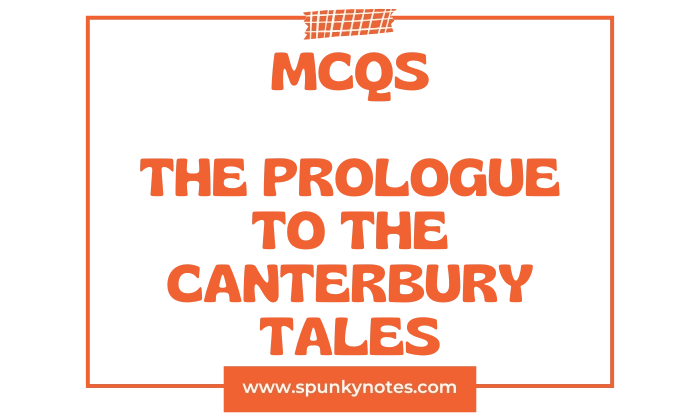

Estimated Reading Time: 18 min
The Canterbury Tales MCQS
1. According to the General Prologue, in which month does the pilgrimage to Canterbury begin?
A. March
B. May
C. April
D. June
2. Where do the pilgrims initially gather before starting their journey?
A. London Bridge
B. Westminster Abbey
C. Canterbury Cathedral
D. The Tabard Inn in Southwark
3. To which holy shrine are the pilgrims travelling?
A. The shrine of St. George
B. The shrine of St. Thomas a Becket
C. The tomb of St. Edmund
D. The Holy Land
4. What is the name of the Host of the Tabard Inn who proposes the storytelling game?
A. John Wyclif
B. Thomas Becket
C. Geoffrey Chaucer
D. Harry Bailey
5. What is the prize for the pilgrim who tells the best story?
A. A golden cup
B. A supper at the Host’s inn paid for by the others
C. A new horse
D. Free passage to Jerusalem
6. How many tales was each pilgrim supposed to tell on the journey?
A. Two on the way there and two on the way back
B. One on the way there and one on the way back
C. Four on the way there and four on the way back
D. Three on the way there and three on the way back
7. How many pilgrims, including Chaucer the narrator, gather at the Tabard Inn?
A. Twenty-four
B. Thirty
C. Twenty-nine
D. Twenty-six
8. Based on the Host’s original proposal, how many tales was Chaucer’s ambitious scheme intended to include in total?
A. Around 120
B. 24
C. 58
D. 32
9. How many tales did Chaucer actually complete before his death?
A. 20
B. 32
C. 24
D. 29
10. Which literary form does The Canterbury Tales exemplify by binding disconnected stories within a single story?
A. An epic poem
B. A historical chronicle
C. A tragedy
D. A collection of tales with a frame narrative
11. From which Italian author’s work, the Decameron, may Chaucer have drawn influence for the frame narrative structure?
A. Virgil
B. Dante
C. Boccaccio
D. Petrarch
12. The General Prologue is a notable example of what medieval genre that satirizes the different social classes?
A. Beast Fable
B. Chivalric Romance
C. Estates Satire
D. Fabliau
13. What kind of verse is predominantly used in The Canterbury Tales?
A. Heroic couplets
B. Alliterative verse
C. Rhyme Royal
D. Blank verse
14. The pilgrims’ journey is described as a “snapshot” or “miniature” of what?
A. Religious reforms
B. Political structures
C. Economic activities
D. English social life and diversity
15. Which of the following are the two prose tales found within The Canterbury Tales?
A. The Tale of Melibeus and The Parson’s Tale
B. The Clerk’s Tale and The Merchant’s Tale
C. The Friar’s Tale and The Summoner’s Tale
D. The Parson’s Tale and The Wife of Bath’s Tale
16. The interactions between pilgrims, such as the arguments and tale interruptions, are known as what?
A. The Prologues
B. The Links
C. The Frame Story
D. The Epilogues
17. Chaucer’s pilgrims are described as both “type and individuals.” What does this mean?
A. They embody stereotypical social roles while also having individual characteristics.
B. They are historical figures disguised as fictional characters.
C. They are all exactly alike, representing one type.
D. They are purely fictional and unrealistic.
18. What is the primary purpose of the General Prologue itself?
A. To introduce the pilgrims and their social standing, preparing for their tales.
B. To critique the religious practices of the time.
C. To outline the various literary forms to be used.
D. To present a detailed history of England.
19. In his own prologue, what does the narrator (Chaucer) ask the reader’s forgiveness for?
A. The póor quality of his poetry.
B. Potentially misremembering details about the pilgrims.
C. Speaking plainly and possibly using crude language from the pilgrims’ tales.
D. The great length of the work.
20. Which social class is notably absent from the pilgrimage group?
A. The clergy
B. The merchant class
C. The peasantry
D. The highest level of aristocracy (e.g., dukes, earls)
21. What is the first character described in the General Prologue?
A. The Squire
B. The Host
C. The Knight
D. The Miller
22. What does the Knight’s stained fustian tunic suggest about his character?
A. He is disrespectful to the other pilgrims.
B. He is póor and cannot afford better clothes.
C. He is vain and cares only for appearances.
D. He is immediately setting off on pilgrimage after returning from war, showing his piety.
23. Who is the first pilgrim to tell a tale?
A. The Miller
B. The Knight
C. The Wife of Bath
D. Chaucer himself
24. What is the Squire’s relationship to the Knight?
A. His younger brother
B. His apprentice
C. His son
D. His nephew
25. Which qualities are associated with the Squire, in addition to his knighthood skills?
A. His singing, fluting, and drawing
B. His wisdom and piety
C. His seriousness and studiousness
D. His skill in trade and commerce
26. What is the Prioress’s name?
A. Madame Eglentyne
B. Lady Alice
C. Sister Mary
D. Mother Superior
27. What is a notable characteristic of the Prioress’s table manners?
A. She prefers to eat alone.
B. She eats quickly and noisily.
C. She is fastidious, letting no morsel fall from her lips.
D. She shares all her food.
28. The Prioress’s motto on her brooch, “Amor vincit omnia,” is ironic because:
A. It is a common motto for knights, not nuns.
B. It can mean either divine or romantic love, creating ambiguity.
C. It is written in English instead of Latin.
D. She does not believe in love.
29. What is a notable characteristic of the Monk, contrary to typical monastic life?
A. His poverty
B. His dedication to scholarly pursuits
C. His quiet contemplation
D. His love for hunting and fine horses
30. What is the Friar’s name?
A. Absolon
B. Huberd
C. Oswald
D. Harry
31. The Friar is criticized for hearing confessions and giving easy penance in exchange for what?
A. Prayers
B. Gifts and money
C. Manual labor
D. Political favors
32. How is the Merchant generally portrayed in terms of his demeanor?
A. Gloomy and pessimistic
B. Humble and quiet
C. Stately and outwardly prosperous, but secretly in debt
D. Outspoken and boastful
33. What is the primary focus of the Oxford Clerk’s life?
A. Hunting
B. Trade
C. Courtly love
D. Study and books
34. What is the condition of the Clerk and his horse?
A. They are fat and well-fed.
B. They are thin and póorly dressed.
C. They are adorned with fine silks.
D. They are strong and ready for battle.
35. The Franklin is described as “Epicurus’s own son” because of his love for what?
A. Justice and law
B. Sensual pleasure, particularly food and drink
C. Philosophical debate
D. Solitude and study
36. The five Guildsmen (Haberdasher, Carpenter, Weaver, Dyer, Tapicer) represent what part of society?
A. The land-owning aristocracy
B. The rural peasantry
C. The rising urban middle class of skilled craftsmen
D. The corrupt clergy
37. What physical ailment does the Cook have that might make his food unappetizing?
A. Póor eyesight
B. An ulcer on his shin
C. A limp
D. A missing finger
38. What is the Doctor of Physic’s main focus of interest, besides medicine?
A. Theology
B. Gold
C. Philosophy
D. Agriculture
39. How many husbands has the Wife of Bath had?
A. Seven
B. One
C. Five
D. Three
40. What is a key theme of the Wife of Bath’s Prologue?
A. The importance of charity
B. Her arguments for female sovereignty in marriage, based on her experience
C. The history of her travels
D. Her spiritual journey
41. The Parson is presented as an ideal member of the clergy. What is his primary characteristic?
A. His wealth and influence
B. His ambition for promotion
C. His devoutness, poverty, and dedication to his flock
D. His love for fine clothing and hunting
42. Who is the Parson’s brother?
A. The Miller
B. The Reeve
C. The Ploughman
D. The Manciple
43. What musical instrument does the Miller play to lead the pilgrims out of town?
A. A flute
B. A harp
C. A trumpet
D. The bagpipes
44. What action does the Miller take that interrupts the Host’s plan for the tales?
A. He refuses to tell a tale.
B. He falls asleep.
C. He insists on telling his tale out of turn while drunk.
D. He argues with the Knight.
45. What physical characteristic is associated with the Summoner’s face?
A. Rosy cheeks
B. Pale complexion
C. Carbuncles and pimples
D. A long beard
46. What is the Pardoner’s profession?
A. A pilgrim leader
B. A religious reformer
C. One who sells papal indulgences and fake holy relics
D. A legal advisor
47. What does the Pardoner frankly confess about his own character in his prologue?
A. His deep piety
B. His unwavering honesty
C. His personal avarice and use of his preaching for profit
D. His shyness
48. Who does the Pardoner travel with on the pilgrimage?
A. The Monk
B. The Friar
C. The Summoner
D. The Parson
49. How does Chaucer portray himself as a pilgrim in the tale-telling contest?
A. As the most eloquent storyteller
B. As a strict judge
C. As a bumbling and incompetent storyteller whose tale is interrupted
D. As a silent observer
50. What is the Host’s reaction to Chaucer’s tale of Sir Thopas?
A. He praises its originality.
B. He asks for more.
C. He rudely interrupts it, calling it “drasty rhyming.”
D. He falls asleep.
Brief Overview
The General Prologue is the introduction to Geoffrey Chaucer‘s The Canterbury Tales. The narrator, Chaucer himself, is staying at the Tabard Inn in London. He is preparing to go on a religious pilgrimage to the shrine of Thomas Becket in Canterbury.
While at the inn, he is joined by a diverse group of 29 other pilgrims. The narrator takes time to describe each pilgrim in detail. He describes their physical appearance, their clothes, their jobs, and their personalities, often in a humorous or satirical way.
The group includes characters from every part of society. There is a noble Knight, a corrupt Friar, a worldly Prioress, a poor Parson, and a bawdy Wife of Bath, among many others. This group represents a complete cross-section of 14th-century English life.
The Host of the inn, Harry Bailly, decides to join them on the journey. He proposes a game to pass the time. He suggests that each pilgrim tell two stories on the way to Canterbury and two stories on the way back.
The Host says he will be the judge of the contest. The pilgrim who tells the best story will win a free dinner, paid for by everyone else, when they return to his inn. The pilgrims all agree to his plan, and they set off on their journey the next morning.


